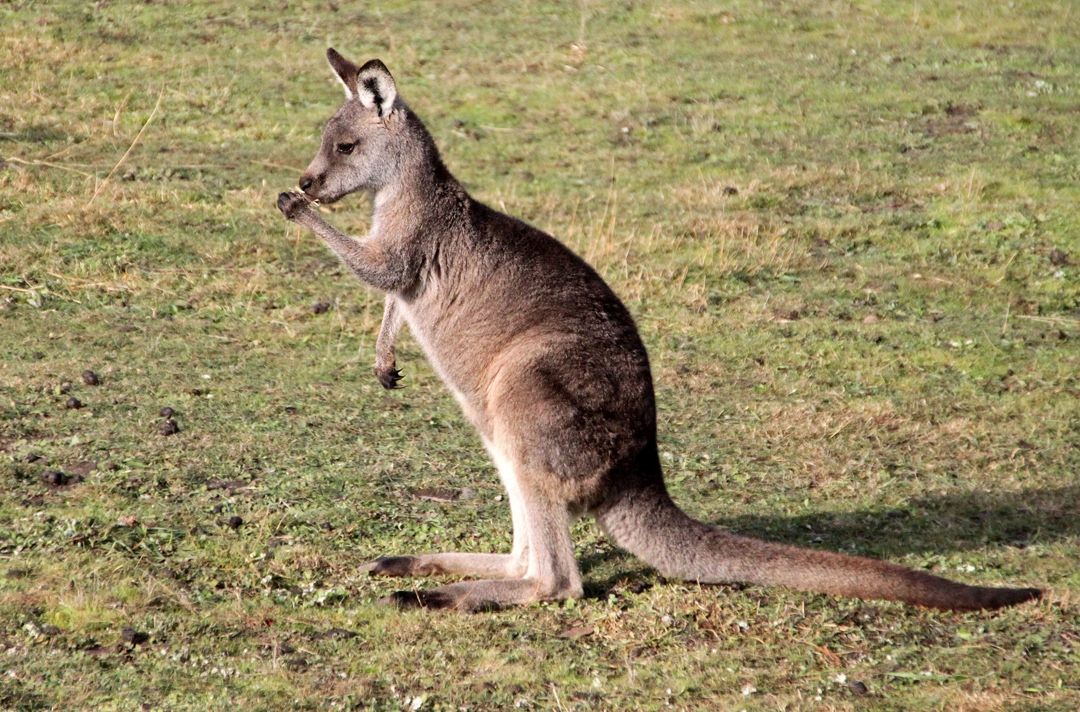Southpaws Down Under: Most Kangaroos Are Lefties

Those boxing kangaroos have a secret: They're southpaws.
New research finds that the eastern gray kangaroo (Macropus giganteus) and the red kangaroo (Macropus rufus) prefer to use their left forelimbs when feeding and grooming. (No word on fighting, which kangaroos tend to do in a boxer stance, leading to cartoon portrayals of the animals in boxing gloves.)
The discovery of handedness in kangaroos is surprising, scientists said. Though hand (or paw) preferences have been noted in some animals, humans are considered unique in showing a strong preference on a population level: About nine out of 10 people are right-handed.
As marsupials, kangaroos are well removed from the primate lineage, suggesting that handedness is something that has evolved independently over time, researchers said.
"What we observed in reality, we did not initially expect," study leader Yegor Malashichev of Saint Petersburg State University in Russia said in a statement. "But the more we observed, the more it became obvious that there is something really new and interesting in the wild."
Pick a hand
Malashichev previously found that some species of walking frogs show handedness, while jumping frogs are less likely to do so. Other researchers have studied handedness in great apes, both in captivity and the wild, but have found evidence for a preference only on certain tasks. Chimpanzees might prefer using their left hands while fishing for termites and their right hands for cracking nuts, researchers reported in 2005 in the journal Proceedings of the National Academy of Sciences.
Sign up for the Live Science daily newsletter now
Get the world’s most fascinating discoveries delivered straight to your inbox.
Humans, by contrast, tend to stick with one hand preference: Righties don't typically switch to left-handedness just to eat, for example.
In the new study, Malashichev and his colleagues observed four species of marsupial in the wild: the eastern gray and red kangaroos, as well as the red-necked wallaby (Macropus rufogriseus) and the Goodfellow's tree-kangaroo (Dendrolagus goodfellowi). [Photos: Kangaroos Use Their Tails to Walk]
The wallaby and the tree-kangaroo showed inconsistent handedness, not unlike nonhuman great apes. For example, red-necked wallabies preferred using their left paws while grooming or while standing on their hind legs to eat, but they switched to using their right paws to eat while standing in a three-legged pose. The Goodfellow's tree-kangaroo showed no particular handedness at all.
Two-legged lefties
But eastern gray and red kangaroos were overwhelmingly lefties, the researchers report today (June 18) in the journal Cell Biology. These kangaroos used their left paws more frequently regardless of whether the animals were standing on two limbs, four limbs or three.
The likelihood of developing paw preferences doesn't seem to depend on the family to which a species belongs, Malashichev and his colleagues wrote. Members of different families show similar levels of hand lateralization, while closely related species vary. All four species studied in the new research were from the same family, Macropodidae, and yet some were clear lefties while others switched hand preferences based on their activities, or showed no preferences at all.
This lack of familial pattern suggests that handedness may develop in response to certain ecological challenges, the researchers wrote. Marsupials that more frequently move around on two legs tend to have higher levels of handedness, suggesting that bipedalism may drive the adaptation, the scientists said.
However, little is yet known about how handedness works in the marsupial brain. In humans, the left and right halves, or hemispheres, of the brain are specialized. This specialization of function seems related to handedness, though exactly how is not clear. To date, no one knows much about the symmetry — or lack thereof — of the motor regions of the marsupial brain, Malashichev and his colleagues wrote.
Follow Stephanie Pappas on Twitterand Google+. Follow us @livescience, Facebook& Google+. Original article on Live Science.

Stephanie Pappas is a contributing writer for Live Science, covering topics ranging from geoscience to archaeology to the human brain and behavior. She was previously a senior writer for Live Science but is now a freelancer based in Denver, Colorado, and regularly contributes to Scientific American and The Monitor, the monthly magazine of the American Psychological Association. Stephanie received a bachelor's degree in psychology from the University of South Carolina and a graduate certificate in science communication from the University of California, Santa Cruz.











